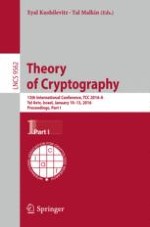2016 | OriginalPaper | Buchkapitel
Output-Compressing Randomized Encodings and Applications
verfasst von : Huijia Lin, Rafael Pass, Karn Seth, Sidharth Telang
Erschienen in: Theory of Cryptography
Verlag: Springer Berlin Heidelberg
Aktivieren Sie unsere intelligente Suche, um passende Fachinhalte oder Patente zu finden.
Wählen Sie Textabschnitte aus um mit Künstlicher Intelligenz passenden Patente zu finden. powered by
Markieren Sie Textabschnitte, um KI-gestützt weitere passende Inhalte zu finden. powered by
Abstract
-
Impossibility in the Plain Model: Assuming the existence of subexponentially secure one-way functions, subexponentially-secure sublinear RE does not exists. (If additionally assuming subexponentially-secure \(\mathbf{iO } \) for circuits we can also rule out polynomially-secure sublinear RE.) As a consequence, we rule out also puncturable \(\mathbf{iO } \) for Turing machines (even those without inputs).
-
Feasibility in the CRS model and Applications to iO for circuits: Subexponentially-secure sublinear RE in the CRS model and one-way functions imply \(\mathbf{iO } \) for circuits through a simple construction generalizing GGM’s PRF construction. Additionally, any compact (even with sublinear compactness) functional encryption essentially directly yields a sublinear RE in the CRS model, and as such we get an alternative, modular, and simpler proof of the results of [AJ15, BV15] showing that subexponentially-secure sublinearly compact FE implies iO. We further show other ways of instantiating sublinear RE in the CRS model (and thus also iO): under the subexponential LWE assumption, it suffices to have a subexponentially secure FE schemes with just sublinear ciphertext (as opposed to having sublinear encryption time).
-
Applications to iO for Unbounded-input Turing machines: Subexponentially-secure compact RE for natural restricted classes of distributions over programs and inputs (which are not ruled out by our impossibility result, and for which we can give candidate constructions) imply \(\mathbf{iO } \) for unbounded-input Turing machines. This yields the first construction of \(\mathbf{iO } \) for unbounded-input Turing machines that does not rely on (public-coin) differing-input obfuscation.
